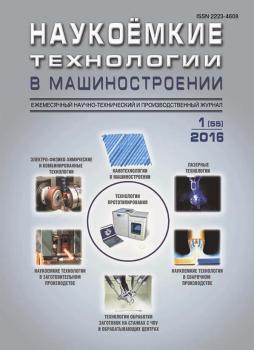Moskva, Moscow, Russian Federation
Tula, Tula, Russian Federation
UDK 621.774.4 Производство бесшовных труб электролитическими способами
The relations for calculating the deformation mode and force conditions of isothermal extrusion of blanks made of high-strength metallic alloys are proposed. Under isothermal deformation, the material is hardened and softened, which is associated with the manifestation of the viscous properties of the material (creep). In this regard, the state of viscoplasticity is taken on. The deformation state is accompanied by stress relaxation, which is greater the lower the speed (longer duration) of the operation. Based on the mechanics of deformation, the dependence of moulding conditions (deformation, force, damage to the work material) is expressed by analytical relations. The power balance of activity of forces results in a pressure estimation for isothermal exposure. In this case, a discontinuous field of path velocities is used, which consists of a block of deformations and rigid blocks. The blocks are separated by slip surfaces. Deformations occur in the deformation block and on slip surfaces. Since pressing leads to the occurrence of micro-damages, the damage rate of the coating material was estimated. In this case, the criteria of fracture kinetics are used: energy and deformation equations. The damage rate of the material depends on the speed and degree of deformation, or solely on the degree of deformation. For a number of materials, reducing the speed helps to reduce damage and, consequently, the possibility of increasing the degree of shaping of the primary blank. The relations for stiffness analysis of the stress pattern are given, on which the damage also depends. Calculations of the pressure and damage of the material under compaction for blanks made of titanium and high-strength aluminum alloys have been performed. It is shown that at low operation speeds on the appropriate hydraulic forging equipment, the exposure pressure decreases significantly. The aluminum alloy damaging is also reduced, and for titanium it depends only on the degree of forming.
viscoplasticity, kinematics, velocity field, power, pressure, material damage rate
Введение
Процессы изотермического прессования применяют в обработке давлением заготовок из высокопрочных сплавов [1]. Нагрев производят в штампе и поддерживают в процессе формоизменения. При этом деформируемый материал проявляет вязкие свойства. Происходит его упрочнение и разупрочнение в связи с релаксацией напряжений. Релаксация увеличивается при снижении скорости операции, что влияет на силовой и деформационный режимы [2, 3]. Это влияние необходимо учитывать при технологических расчетах. Для ряда процессов изотермической объемной штамповки такие расчеты приведены в работе [4]. Схема прессования приведена на рис. 1, а. Используется верхнеграничный энергетический метод расчета используя кинематику деформирования с помощью разрывного поля скоростей перемещений [3, 4].
Кинематика, мощность, давление
Установим кинематику деформирования, введя разрывное поле скоростей перемещений (см. рис. 1, а). Поле состоит из блока деформаций «1» и жестких блоков «0», «2». Оснастка обозначена как блок «3». Блоки разделены поверхностями разрыва скоростей с образующими линиями «01» и «12» и ограничены контактной поверхностью трения «13». Длины образующих линий «01», «12» и «13» соответственно
Деформации происходят в блоке «1» и на поверхностях разрыва скоростей. В блоке деформаций скорость перемещения материала заготовки по конусу представим функцией текущего радиуса заготовки на конусе матрицы,
Функция (2) соответствует граничным условиям для скорости на входе и выходе из блока деформаций, т. е.:
Обратимся к поверхностям разрыва скоростей, используя план скоростей (рис. 1, б).
На поверхности S01 имеем:
где vn и vτ – нормальная и касательная скорости.
Запишем соотношения для эквивалентных деформации, скорости деформации и напряжения, учитывая выражения (7). Таким образом:
1. Изотермическое прессование на гидропрессовом оборудовании производится в условиях вязкопластического деформирования. Деформационное упрочнение материала заготовки сопровождается релаксацией напряжений во времени.
2. Величина давления зависит от длительности операции и уменьшается при малых скоростях формоизменения.
3. Повреждаемость материала заготовки может зависеть от скорости или только от степени деформирования. На величину повреждаемости влияет так же жесткость схемы напряжений.
1. Forging and stamping: Handbook: in 4 volumes, vol. 2. Hot volume stamping / edited by E.I. Semenov. Moscow: Mashinostroenie, 2010, 720 p.
2. Isothermal shaping of anisotropic materials / S.S. Yakovlev, S.P. Yakovlev, V.N. Chudin et al. Moscow: Mashinostroenie, 2009, 412 p.
3. Theory of metal forming by pressure / ed. Golenkova V.A., Yakovleva S.P. et al. Moscow: Mashinostroenie, 2009, 442 p.
4. Chudin V.N., Pasynkov A.A. Nonstationary processes of isothermal stamping// Forging and stamping production. Pressure metal treatment. 2018, no.6, pp. 23–28.
5. Dwight G.B. Tables of integrals. Moscow: Nauka. 1973, 228 p.
6. Kolmogorov V.L. Mechanics of pressure metal treatment. Moscow: Metallurgia, 1986, 688 p.
7. Gong G.Ya. Theoretical foundations of pressure metal treatment. Moscow: Metallurgia, 1980, 456 p.
8. Nuzhdin G.A., Galkin Yu.S., Hrichev I.S. Assessment of the nature of metal flow under extrusion with squirting // News of TulSU. Technical sciences. 2023, issue 9, pp. 631–634.
9. Chernyaev A.V., Usenko N.A., Korotkov V.A., Platonov V.I. Understanding how deformation rate influences the resistance to deformation under static tension at high temperature // Non-ferrous metals, 2019, no. 5, pp. 60–66.
10. Pasynkov A.A., Larin S.N., Isaeva A.N. Theoretical substantiation of reverse isothermal extrusion scheme of pipe billet with active friction and drawing of its edge part // Blanking productions in mechanical engineering, 2020, no. 10, pp. 462–465.
















